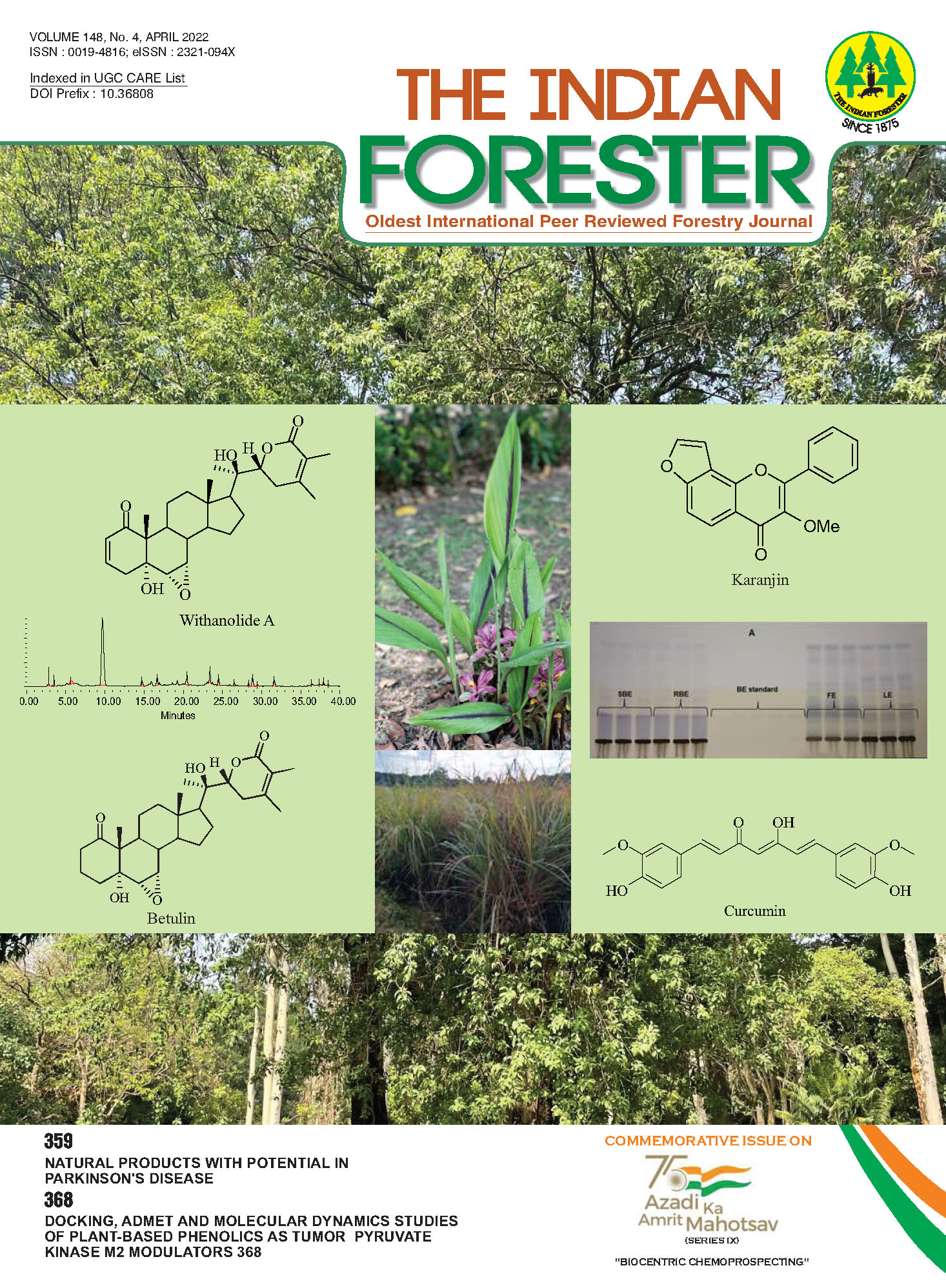Docking, ADMET and Molecular Dynamics Studies of Plant-Based Phenolics as Tumor Pyruvate Kinase M2 Modulators
DOI:
https://doi.org/10.36808/if/2022/v148i4/168345Keywords:
ADMET, Docking, MD Simulations, PKM2, Phenolics.Abstract
The drug discovery is presently threatened by exorbitant costs and is less productive. To challenge the deterioration in the throughput curve, pharmaceutical corporations, and academic scientists are leaning towards plant-based molecules to ascertain new molecules to convert them into pharmacotherapies, and phenolics are the molecules of choice. Natural products, specifically phenolics are undoubtedly explicit sources for development of effective drugs either totally or in a semi-synthetic way and there are numerous examples to support this statement. Molecular docking is chiefly employed to predict novel lead compounds for drug discovery. In this study, phenolics known to act as tumor pyruvate kinase M2 (PKM2) modulators and considered as anticancer agents were subjected to docking studies using Glide and rigorous in silico ADMET studies using the Qikprop suite. In silico investigations were carried out to find out the explicit interactions of the phenolics with PKM2 (PDB IDs 3GR4 and 4B2D) modulators. The docking studies were carried out on phenolics reported as PKM2 modulators. Myricetin was found to be the most suitable anticancer agent for the PKM2 modulation acting on the DASA-binding site with a glide score of -10.746. In addition, the effectiveness of the study was further validated by performing ADMET studies of all the modulators which again established myricetin to be the most favourable one among the selected compounds. It suggested that amongst the “hit list”, myricetin shares the best features to be considered ahead for drug discovery. The results of molecular dynamics simulation studies of myricetin with the DASA-binding pocket of human pyruvate kinase M2 (PDB ID- 3GR4) are strongly in concert with complementary experimental methods discussed above.References
Almeida A.F., Dos Santos C.N. and Ventura M.R. (2018). Polyphenols, their Metabolites and Derivatives as Drug Leads, Current pharmaceutical design, 24(19): 2188-2207.
Anastasiou D., Poulogiannis G., Asara J.M., Boxer M.B., Jiang J., Shen M. and Auld D.S. (2011). Inhibition of pyruvate kinase M2 by reactive oxygen species contributes to cellular antioxidant responses, Science, 334(6060): 1278–1283.
Bhosale P.B., Ha S.E., Vetrivel P., Kim H.H., Kim S.M. and Kim G.S. (2020). Functions of polyphenols and its anticancer properties in biomedical research: a narrative review, Translational Cancer Research, 9(12): 7619–7631.
Dougherty T.J. (1974). Activated dyes as antitumor agents, Journal of the National Cancer Institute, 52(4): 1333–1336.
Gelpi J. (2015). Hospital A, Goñi R, Orozco M. Molecular Dynamics Simulations: Advances and Applications, Advances and Applications in Bioinformatics and Chemistry, 8: 37–47.
Gornik H.L. (1997). Cancer undefeated, N Eng J Med., 336(22): 1569–1574.
Hashida M. (2005). In silico Prediction of Pharmacokinetic Properties, YAKUGAKU ZASSHI, 125(11): 853–861.
Hazafa A., Rehman K.-U.- Jahan N. and Jabeen Z. (2020). The role of polyphenol (flavonoids) compounds in the treatment of cancer cells, Nutrition and Cancer, 72(3): 386–397.
Kale A.J., McGlinchey R.P., Lechner A. and Moore B.S. (2011). Bacterial self-resistance to the natural proteasome inhibitor salinosporamide A, ACS Chemical Biology, 6(11): 1257–1264.
Kalirajan, Rajagopal Sankar S., Jubie S. and Gowramma B. (2017). Molecular Docking studies and in-silico ADMET Screening of Some novel Oxazine substituted 9-Anilinoacridines as Topoisomerase II Inhibitors, Indian Journal of Pharmaceutical Education and Research, 51(1): 110–115.
Mann J. (2002). Natural products in cancer chemotherapy: past, present and future, Nature Reviews Cancer, 2(2): 143–148.
Noble R.L. (1990). The discovery of the vinca alkaloidschemotherapeutic agents against cancer, Biochemistry and Cell Biology, 68(12): 1344–1351.
Patel S., Das A., Meshram P., Sharma A., Chowdhury A., Jariyal H. and Sahu B. (2021). Pyruvate kinase M2 in chronic inflammations: a potpourri of crucial protein–protein interactions. Cell Biology and Toxicology, 37: 653–678.
Patle R., Shinde S., Patel S., Maheshwari R., Jariyal H., Srivastava A. and Tekade R.K. (2021). Discovery of boronic acid-based potent activators of tumor pyruvate kinase M2 and development of gastroretentive nanoformulation for oral dosing, Bioorganic and Medicinal Chemistry Letters, 42: 1–11.
Polyzos A., Tsavaris N., Kosmas C., Giannikos L., Katsikas M., Kalahanis N. and Stamatiadis D. (1999). A comparative study of intraperitoneal carboplatin versus intravenous carboplatin with intravenous cyclophosphamide in both arms as initial chemotherapy for stage III ovarian cancer, Oncology, 56(4): 291–296.
Rajagopal K., Varakumar P., Aparna B., Byran G. and Jupudi S. (2021). Identification of some novel oxazine substituted 9anilinoacridines as SARS-CoV-2 inhibitors for COVID-19 by molecular docking, free energy calculation and molecular dynamics studies, Journal of Biomolecular Structure and Dynamics, 39(15): 5551–5562.
Rathod B., Chak S., Patel S. and Shard A. (2021). Tumor pyruvate kinase M2 modulators: a comprehensive account of activators and inhibitors as anticancer agents, RSC Medicinal Chemistry, 12: 1121–1141.
Richardson P.G., Zimmerman T.M., Hofmeister C.C., Talpaz M., Chanan-Khan A.A., Kaufman J.L. and Reich S. (2016). Phase 1 study of marizomib in relapsed or relapsed and refractory multiple myeloma: NPI-0052-101 Part 1, Blood, The Journal of the American Society of Hematology, 127(22): 2693–2700.
Saide A., Damiano S., Ciarcia R. and Lauritano C. (2021). Promising Activities of Marine Natural Products against Hematopoietic Malignancies, Biomedicines, 9(6): 645.
Sen T., Barrow C.J. and Deshmukh S.K. (2019). Microbial pigments in the food industry-challenges and the way forward, Frontiers in Nutrition, 6: 7.
Wong N., Ojo D., Yan J. and Tang D. (2015). PKM2 contributes to cancer metabolism, Cancer Letters, 356(2): 184–191.
Zhou Y., Zheng J., Li Y., Xu D.P., Li S., Chen Y.M. and Li H. (2016). Natural polyphenols for prevention and treatment of cancer, Nutrients, 8(8): 1–35.
Downloads
Downloads
Published
How to Cite
Issue
Section
License
Unless otherwise stated, copyright or similar rights in all materials presented on the site, including graphical images, are owned by Indian Forester.





